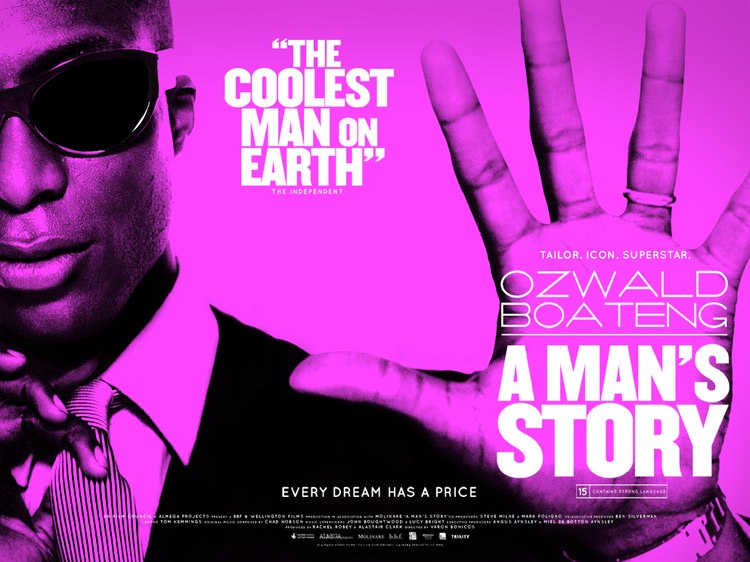[Editor’s Note: the article below appears today at The Huffington Post.]
By Govindini Murty & Jason Apuzzo. During his meteoric career, Ozwald Boateng’s been called the coolest man on Earth, and the fashion world’s best-kept secret. Yet the candid new documentary A Man’s Story, opening this weekend in New York and Los Angeles, makes certain that the British fashion designer and style icon no longer remains a secret.
In a career already spanning two decades, the 45 year-old Boateng has outfitted celebrities from Will Smith to Russell Crowe, from Jamie Foxx to Mick Jagger. At age 28, he became the youngest tailor – and the first of African descent – to open a store on London’s legendary Savile Row. Boateng’s also designed menswear for Givenchy and bespoke costumes for films like The Matrix and Ocean’s Thirteen, and he’s even been the subject of his own Sundance Channel TV series, House of Boateng. He’s also the recipient of an OBE (Order of the British Empire) for his contributions to the clothing industry.
Throughout all this, however, Boateng’s private side – such as his quiet struggles in the rarified world of British fashion, or his efforts to foster entrepreneurial investment in Africa – have taken a back seat in public to his style innovations.
Director Varon Bonicos’ new documentary, A Man’s Story – for which Bonicos filmed Boateng from 1998 through 2010 – reveals much about Boateng’s personal life: from the challenges of growing up as a young man of African descent in London of the ’70s and ’80s, to the abiding influence of his father on his life and career. The result is a warm and often poignant film that humanizes Boateng, while doing full justice to the glamorous place he occupies in the world of men’s fashion.
We spoke with Ozwald Boateng and Varon Bonicos in Los Angeles, where they are promoting A Man’s Story. The interview has been edited for length.
GM: What is your passion for film – and in particular, how are you inspired by the intersection of film and fashion?
OB: Film has always been a really good tool for me to communicate emotion about why I create a collection. I’m probably one of the first designers to make short films. The first time I did it was back in 1994. The invite for my first fashion show was a VHS cassette. And it kind of became part of the language of my designing collections – I was always putting together short films.
Apart from that, I think fashion designers are directors anyway. We spend a year designing a collection for a fashion show that lasts maybe fifteen minutes. We have to design the look of the catwalk, cast the model for each look, work up the sound, the lighting – it’s a lot of work that goes into that fifteen minutes.
JA: Film has been so important in terms of influencing men’s style, men’s self-perceptions. I was curious whether there were film icons, movie stars who have influenced your sense of style?
OB: Sean Connery, of course, since I was a kid – you know, James Bond. Or The Thomas Crown Affair – you can’t beat those three piece suits. The Italian Job with Michael Caine – again the suits. If you’re a designer, there’s got to be some films that you’ve seen that have inspired you creatively. There’s no escaping that. Film is such a very good tool for communicating emotions, and all designers and creative people look to inspire an emotional response.
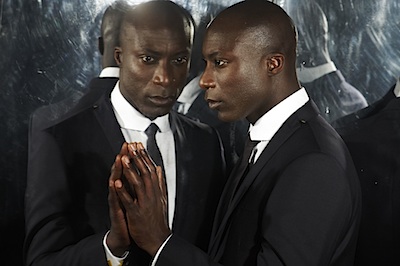
JA: You mention Connery and Bond, and he was so crucial in selling the Savile Row style here in the States.
OB: Absolutely.
JA: You yourself have become an icon on behalf of that style. Was that something you planned from the outset as a designer – to be so out front selling the look yourself?
OB: No, actually, I tried to stay out of it. In the early years, it was because I was a very young guy working in a very old discipline – so really, that’s tough to begin with. And then I was trying to do it in a very modern way – so again, that’s tough. Add me, visually, into the mix of all that, and that just complicates things. So for the first few years, I didn’t let anyone take any pictures of me. Basically, a lot of people had no idea what I looked like. And because my name did not necessarily sound African, a lot of people … just thought I was some kind of middle aged white guy [laughs]. So no-one actually knew what I looked like, and that was the best thing – because it allowed everyone to focus on the work.
JA: You were hidden, basically.
OB: Yeah, but it was all very deliberate. Because I’m good at what I do, and I just wanted to focus on the work. Let people talk about my cut, the influence of the cut, the detail, and that’s all it was about – for years.
And then there was this famous magazine in London called The Face – this was in the late ’80s, early ’90s – and that’s the first time I kind of revealed myself. And the reason was that the journalist was so adamant that she take a picture, and I was fighting it and fighting it, and anyway, I did it. And then the moment I had the picture taken, the dynamics completely changed. I got a lot more interest, but the interest always came back to that they wanted to take a picture of me – and that’s when I got into Italian Vogue, and all those magazines at that time.
GM: One of the most powerful parts of your story is that you are of Ghanaian descent, you were born in London – and you broke into a place as tradition-bound as Savile Row. How was your background as an African an asset to you – in your fashion, in your creative work – and at the same time, what challenges did it pose that you had to overcome?
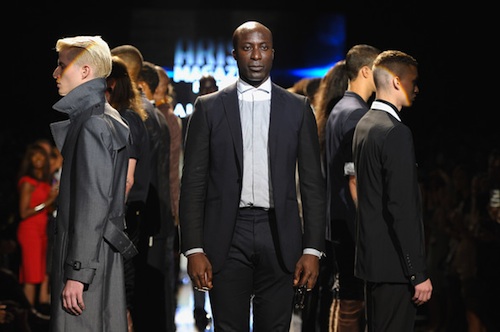
OB: As I say very early on in the film, at the time I was growing up, it was tricky. You had two options: allow it to become a headache, or just get on with your life [laughs]. So I chose to just get on with my life and not let it bother me. So even when I was experiencing real issues, I just didn’t see it. So, I think that when someone’s got an issue about where you’re from, and they’re going at you – and you ignore it … it makes them powerless.
So that’s been my way of dealing. When I went to school, there were two black kids in the whole school. I think the first time I saw only black people was when I went to Ghana – I must have been 21, or 22, at that time. To have that visual experience – I remember going, “oh, wow – I’ve not seen that before.”
GM: You’re very proud of your culture and of the artistry that comes with it. And you have collections inspired by African style, but also by Japanese samurai style, Native American culture, Russian style. You show all this interest in different cultures – and I think in part that’s because you yourself come from a culture different from that of the UK.
OB: Exactly. And that’s why Savile Row was so relevant, because Savile Row is an important street in British history. So my opening a shop there had much greater meaning than just opening a store. And I think, subconsciously, I was aware of that. Because I’m always about change for a greater meaning. But the way to do it is without putting any badges on it. Because the more you put a badge on something, the more it becomes something else.
GM: I’d like to ask you about your commitment to helping Africa through development. You’ve said in your interviews that you believe private investment and entrepreneurship are more effective in helping Africa than government aid.
OB: Yes, absolutely.
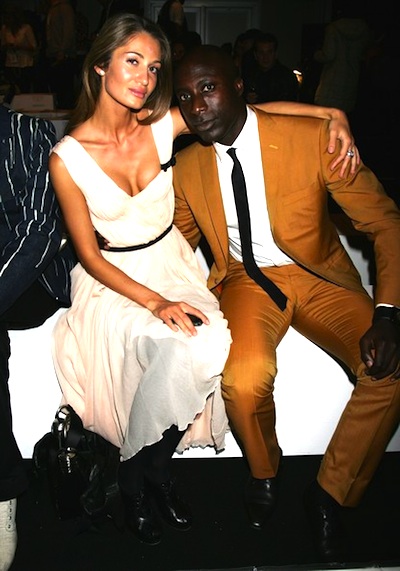
GM: I’d love to hear more about your philosophy and how you think you can accomplish your goals through your Made in Africa Foundation and also through this film.
OB: Designers are creating for the future … [we’re] basically visionaries … so when you visualize something, you don’t visualize it to be worse than it is, you visualize it to be better [laughs]. That’s how designers think. So when I go to Africa, I don’t visualize it being worse, I visualize that if we did everything right, what would that look like, and suddenly it’s an amazing vision.
Africa controls 50% of the world’s natural resources, in some cases 70% – so the concept of poverty [in Africa] makes no sense. And in the world, resources are key. So when you understand those points, the only thing left is: ‘why?’ And the ‘why’ is the infrastructure. So infrastructure development is the key. And you balance that out with how much aid has been invested, which is billions, and of the aid money that’s been put in, if 20% actually hit the ground and got deployed, I’d be shocked. So that’s why I set up the foundation.
In terms of what we’re dealing with: we’ve written a paper for the British government on policy for Africa, we’ve campaigned the World Bank, the African Development Bank – and the African Development Bank is doing a $22 billion dollar infrastructure bond. So now there’s more interest in investment in Africa than there’s ever been since I can remember. The main thing we’ve done in Africa is to change views, which is the key.
JA: For both of you, what is the big takeaway that you want people to have on this film? And Varon, you put twelve years into this – all that footage going back to the late ’90s. We see documentaries all the time, and no-one is rolling cameras over that length of time.
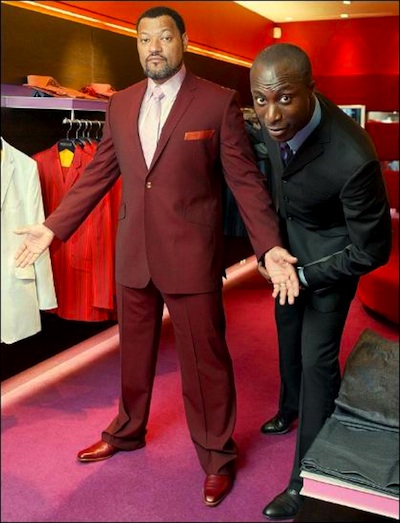
VB: The film is 96 minutes out of five hundred and something hours. It was really hard to craft. It’s like little tiny dots of newsprint – and then you pull out, and you get the picture. The editor Tom Hemmings had to sit in a darkened room for two months just watching footage. But you know, I met Ozwald and I’d never met anyone like him before. I was only supposed to film for a few weeks … [but it wound up being twelve years]. The central message of the film really is about belief, the core structure of belief. It’s got a man’s story – and fashion, it’s a great backdrop. The film also highlights one of the most important relations in life, which is a relationship between a parent and a child. But the central message is about belief. I’m proud of the film. It’s great to be sitting here with you to be able to talk about it.
OB: I think each person’s going to take a very personalized viewpoint about what the film’s doing for them. I make bespoke suits that are made to fit men as individuals – and that’s somehow worked through the film, [with] the film fitting the individual. That seems to be the poetry of life.
JA: In the final shot of the film, you’re walking off stage with your father. That was very touching. He inspired you – and look what it created. I just thought that was wonderful.
OB: That’s interesting. Many people see the film, but no-one’s mentioned that. So let me tell you about that. I decided I was going to do this fashion show based around this movie, and I called it, “A Man’s Story.” I wanted to figure out: at what point do you become a man? Is it 18, is it 21, is it when you get married, when you have kids? So I’m sitting at dinner with five mates of mine, and the guys say, “actually, you only become a man when you lose your father. It’s when you have a problem, and you can’t call him – because he’s not there.” And I said, “wow.” So at that point I realized I’d done all this stuff, and I’d never celebrated my dad. So my whole focus moved from what I was doing to making it all about him. Which is why, at the end of the show, I’m applauding him. […] So that’s really what A Man’s Story is about. It’s really about your moments, and remembering them. And also, enjoying them as they happen.
VB: I agree. Enjoy every moment as it happens.
A Man’s Story opens in New York and Los Angeles on November 2nd, and is also available in Apple’s iTunes store.
Posted on November 3rd, 2012 at 12:20pm.
